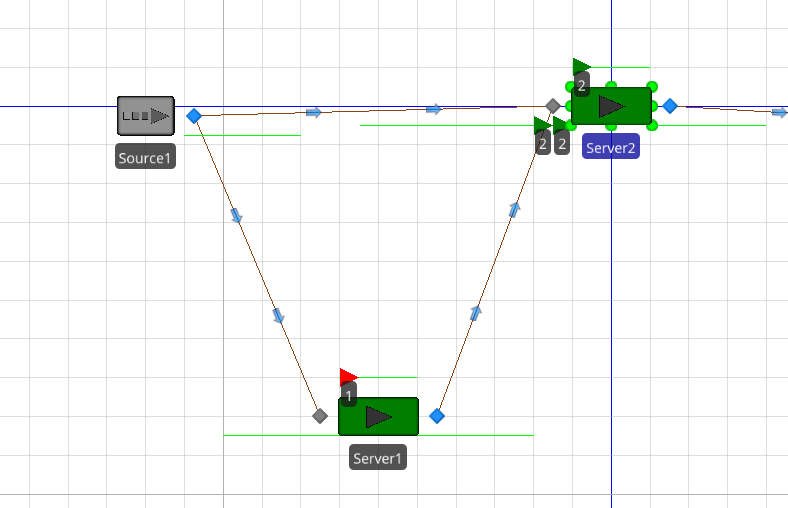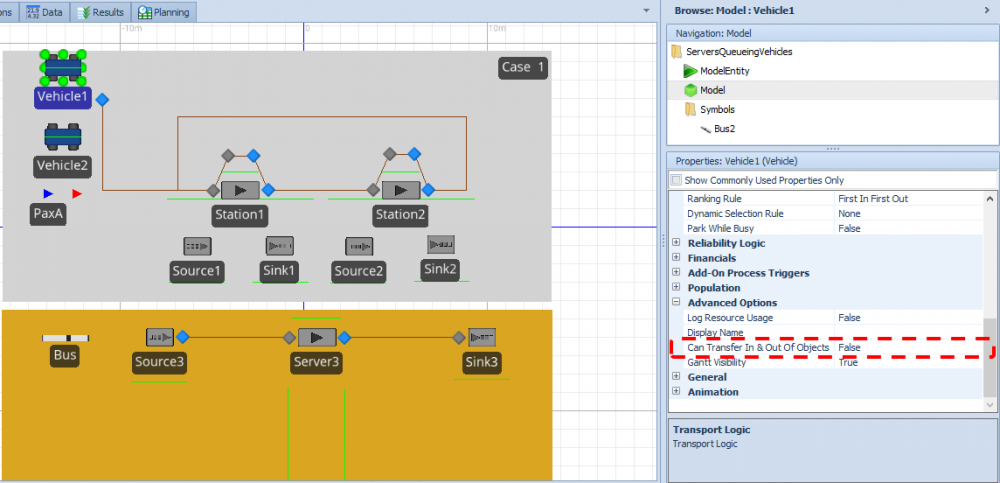Search the Community
Showing results for 'wait in transfer node'.
-

Vehicles Dropping-off at Entity-defined Destination
dsturrock replied to sswann's topic in SI General Discussions
It sounds like the problem is you are not using the internal state that Simio uses to hold the current destination. You have not attached your model or included any logic, but I would say you should consider eliminating your custom state ModelEntity.DropOff and use whatever logic you used to set that to instead set the internal state using the SetNode step or the Entity Destination Type option on any Transfer Node. If you use that, then it will automatically be dropped off at the specified destination node. -
Hello indsiders, I have the following problem, which i broke down for better understanding: The next time Server2 is free, it should select the red entity with the priority 1 (Dynamical labels notify the Entity.Priority) even if the red entity has not reached the input buffer of Server 2 at that specific time. It seems like i need a ranking expression that says: Server2 select Entity.Priority == 1 out of the input buffer. If there is no Entity that matches this condition wait until a entity with the matching condition arrives in the input buffer. I tried the seize, allocate and reserve step. But nothing is realy acceptable. I assume it's an easy problem, but after several hour of trying i gave up :(. Can someome help me ? Best regards, Benjamin
-
Hi Fra, Have you tried changing the Input Buffer Capacity and Output Buffer Capacity to '0'? This will prevent the pieces from queuing in front of the servers because there is no input buffer for them to queue in. Instead, they will queue on the link leading up to the server. If you use a Path, to see pieces queue up behind one another, set the Allow Passing to 'False'. If you want the pieces wait at the current object until the downstream object is available, you can use a Connector (instantaneous travel). For a solution where travel time is required between objects, you can explore using Add-On Process Logic to prevent moving until the downstream object is available. In this instance you would use either a TimePath or Path. All the best, Caleb
-
Hi - I am trying to relocate nodes during run time using Relocate Object step. It works if my nodes are not connected by any links, otherwise it does not. I want my entities to follow a Network Path in Travel step, therefore, it is crucial that my nodes are connected. Any suggestion how I could achieve this? My aim is to avoid collisions when entities travel from one node to other in free space, only way I know to achieve this is through Travel step. Thanks, Zaki
-
You need to re-assign the x and z coords of the node during run time (i.e. Node.Location.X and Node.Location.Z).... Best way to do this is with a table with an object reference property.....
-
Heya, I am experiencing some difficulties, with something that I would like to model. In short I would like to model the following: One road going from A to B by using a source and a Sink. Only trucks (entities) will be on this road, and they will be able to notice which truck is the most nearby. The truck is looking for another nearby ruck to group up with, and will try to form a couple, "Truck Platooning". Until one of them decides to make a turn to a different destination (passes a node, and decides to move to a different sink). During this time the following truck will safe fuel and thus costs. At the moment I am quite stuck with the following. I would like to make use of the find step and vectors. But there are not that many examples around on how to properly use them. I would like to let the entities update their location.x every second in the vector. Meanwhile the entities will use the findstep to find the nearest entitiy, and select this entity to 'catch-up' with. How do I make a list of these entities, and keep updating their location?
-
I've ran into the following problem with a combiner: I'm using it to model a load zone where taxis arrive to the parent node, passengers arrive to the member node, and the number of passengers boarding each vehicle is set by a random.discrete distribution (so that for instance 50% of the taxis have 1 passenger, 30% over 2, and 20% have three). This all works great. But now, instead of having my passengers queue at the input node, I was hoping to make them queue at another upstream node, connected to the member input node by a path and every time a taxi arrives, I would like to send to the combiner only the number of passengers that will be batched with the taxi. I tried using Combiner.BatchQuantity but without success so far. From what I've seen by looking at a display showing Combiner.BatchQuantify, it seems it's continuously going through its possibilities, whether a taxi is at the parent input node or not. Then I thought that maybe the number picked to batch passengers with taxis, was selected from that continuously changing value when a taxi entered the parent node, so I tried using the event ParentInput@Combiner1.Exited (as well as ParentInput@Combiner1.Entered) to extract the batchquantify assigned to that taxi but the value did not match the actual batching. So I guess my question is: is there a way to access the value that is picked by the batching process to use it to send the right number of members to the combiner? Thank you very much for your help. Pascal
-
I want to simulate a touring group utilizing 2 different buses to the same destiny, concurrently there are multi-types of model entities with a unique percentage distribution; "Adult, Teen and Senior", passengers. Finally, at arrival, both groups unloaded from their buses at the same time. My Question is: How I can to batch each group in a separate assembling area, so then they would follow a different group routing? I studied the "Combiner Node" example in the SimBit, can I do it without parent priority logic?
-
I assume that your worker is located at the MemberInput Node of the Cominer I search Queue State, the Queue Name is: MyWorker.Location.Parent.Node.AssociatedObject.MyCombiner.OutputBuffer.Contents
-
1) The model seems working as you intended. The animation seems the logic is not working but in fact the animation is delayed (in the animation the modelentity is at output node of server2 i.e., seems behind the scheule but if you examine trace window the modelentity is just at combiner memberinput buffer.) 2) I think the process logics are not required if you will not use them for further modeling purposes. I mean If you set appropriate parent match expression and member match expression at combiner1 object, the object itself will combine them automatically (it will perform all the operations you performed in your processes). Try not to use them?
-
Note: set selection weight of the path's (from source to picking object's parent input node) selection weight property as modelentity.ParentTrue==True and the path's (from source to picking object's member input node) selection weight property as modelentity.ParentTrue==False.
-
Hi, I wanted to implement in my model that certain entities exhibiting a certain trait will have to go to a certain node in my diagram, while entities exhibiting another trait will have to go to another node in my diagram. This characteristic can be made referenced to in one of my Data Tables, under one of the columns in that table. I also used the Decide step, where I changed the DecideType to "condition based" and wrote the condition as: Datatable[CurrentRowNumber].characteristic > (A number). However, the flow of the entities do not abide by the decision logic. How may I resolve the problem? Thank you!
-
Hi, I currently have a model as follows. I have a separator, and I want to divide entities that enter through it evenly across the 2 nodes. So half of the entities go out from the parent node and half go out of the member node. Currently right now, I did not manage to do it for the separator, even when I tried all possible methods in SIMIO for splitting the batch itself. How may I go about the problem? Thank you!
-
Separator does not seem to be splitting correctly
CWatson replied to JanWai's topic in SI General Discussions
If you have a batched entity (through Batch step or Combiner object), there is only one parent entity and the rest member entities. Thus, one entity exits the parent node, the others exit the member node. If the Separator instead did a Make Copies instead of the Split Batch, you still have the original parent entity (incoming entity) and the member entities (copies). If you need to split the entities in different directions, you should look at having both of those nodes connected to a single node where you then make the decision to go in two different directions. -
Batch Members and Parents Routing
gocken replied to Luu Khanh Minh's topic in SI General Discussions
You should place a seperator just after the combiner object. After seperating them all send five of them to node A and the other to node B. There exist many different ways to perform this. -
In my model, I have a combiner that batch 1 parent entity and 9 member entities together. I then need these 10 entities, when travelling out of the output node of the combiner, to go to 2 different paths. 5 of them should go on a path to node A and 5 of them should go to another path to node B. I tried using Combiner.BatchQuantity at Output_Combiner_Entered Add-on process but it doesn't work. May I have some suggestions? Note that the batch number is not fixed and will vary during the simulation run.
-
Create arrival of source on event
gocken replied to Luu Khanh Minh's topic in SI General Discussions
why do you use source? In Workstation 1_exited step you can just increase the currentrownumber by one using an assign step and use a create step just after this assign step, set its properties using any table (and also currentrownumber state variable). and transfer this entity to the appropriate place. you do not need to use source step? -
Transferring Entity from a Path to a Node
jzhou replied to Marquan's topic in SI General Discussions
You can not directly move a entity currently still ON the Path to a node... -
Hello, I am modeling a range wherein if a workstation encounters a failure while processing an entity, that entity needs to be destroyed and can't simply wait for the workstation to be repaired and then continue processing. The real world application models a failure of a critical piece of gear on boat, which would have to cancel the mission and return to port for repairs. In my case the mission (the entity) cannot wait for the repair, it must be canceled and start the whole process again later. I am really struggling to implement a process where the entity encountering the failure is destroyed when the failure occurs instead of just waiting around. Thanks for any help anyone can offer!
-
So I have a rather complex issue that needs to be resolved basis multiple entities in a wait block. I think this is actually the first decent use I have found for a storage queue as it seems to allow me to shuffle the entities within the wait block, basis entry and exit ranking rules. I can then just use the condition in the wait block to match the specific or subset of entities that adhere to the condition in the storage queue (see attached)
-
Hi there - My entities are going into a wait step based on a condition. So at any point in time I may or may not have multiple entities in the wait step. When I fire an event to release entity from the wait step all the entities which are in the wait step at the time event is fired get released. I don't want that, I want wait to release only one entity every time release event is fired. Any ideas how I can achieve this? Thank you.
-
yes, in my solution a wait step is not required and use storage queue instead of wait step. Be sure it will work.
-
Thank you Gocken but I am so sorry I can't follow. To search specific entity (entity which arrived first in my case) how can I search the queue associated to wait step? Or do you mean I use storage queues instead of wait step.
-
Hi everyone: I am trying to simulate a BRT network which is composed by a set of buses (vehicles) that follow a sequence and schedules as well as some passengers (entities) who are generated by sources, transported by vehicles between bus stations (servers), and unloaded in sinks (acting as destinations). Those stations are connected by bus lanes (paths) that are restricted of overtaking maneuvers. If you check the model attached, in Case 1 (silver pool) the operation aforementioned is briefly modelled. However when the Vehicle 1 is boarding/alighting entities, Vehicle 2 must wait in the input buffer of each server until the vehicle that arrived before have finished its operations (as can be modelled in Case 2 (gold pool) if the bus is created as an entity rather than as a vehicle). I have been trying to fix this problem with an advanced option of the Vehicle' properties called "Can Transfer In & Out of Objects" (as can be seen in the image attached), that is good when a vehicle requires to be processed by a server as an entity. Nonetheless, in this scenario the passengers are not carried anymore by the vehicles which is not good. Could anyone help me with this issue? I will really appreciate your support because I am a new user of this great software . Kind regards, Alfredo Armijos. ServersQueueingVehicles.spfx
-
Thanks for the model provided Mr. Sturrock. I just have one more issue. If you run the attached model you will realize that now the vehicle is able to be processed in both servers. Thereafter, once the vehicle has entered into the Input@Sink1, it should drop off the entities allocated in its RideStation and then come back to the Output@Source1 for continuing with its operation (logic that is specificed in the add-on process Destroying Entity on the Sink 1 through the step Transfer). However, when the vehicle enter in that basic node, the entities remain on its RideStation, the vehicle is being "parked" in the InputBuffer of the Sink1 and the error described in the picture suddenly appears. Could you provide me some advice about the way in which I can resolve this issue? Thanks again for your support. VehicleTransfer.spfx






